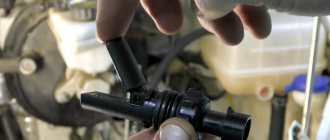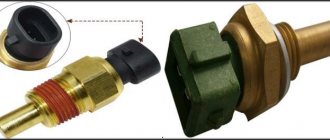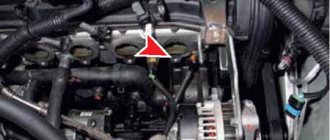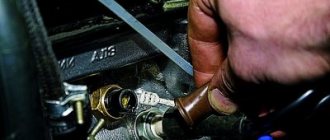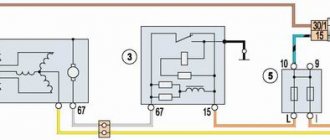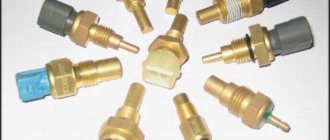Electronic devices for measuring the temperature of antifreeze circulating through the engine water jacket have been used on cars since Soviet times. The breakdown of this element has always been considered a serious problem, since without temperature control in the cooling system, the engine can easily overheat and damage the piston group. Therefore, it is important for a novice motorist to know how to identify the symptoms of a malfunction of a temperature sensor in time, and changing it will not be difficult.
Operating principle and functions of the device
The design and operating principle of the temperature meter have changed little since its first use on a car. Due to modern materials used in the manufacture of the sensor, it has decreased in size, and the accuracy of the readings has increased. The device is a thermal variable resistor enclosed inside a metal case with a threaded tip. When heated, the thermoelement reduces the resistance of the electrical circuit, which allows the electronic control unit (otherwise known as the controller, ECU) to determine the temperature of the coolant.
The following functions depend on the operation of the temperature sensor:
- Traditionally, the coolant temperature indicator operates from meter signals.
- Timely activation of forced engine cooling fans when the antifreeze reaches the set temperature threshold (about 100 °C).
- Enriching the air-fuel mixture and increasing idle speed on a cold engine.
- While driving, the controller collects readings from all sensors and, on this basis, forms the ratio of fuel and air in the mixture. The temperature meter is also involved in this process.
The design of a modern car may provide for the installation of several heating meters responsible for certain functions. Their location varies:
- on the upper pipe leading from the cylinder block to the radiator;
- in the thermostat housing;
- in the cylinder head;
- directly into the radiator.
It is not difficult to distinguish thermocouples from other types of sensors. All devices built into the engine cooling system and connected by wires to the controller are designed for temperature measurements. The only point: when you start looking for the location of the temperature meter for the purpose of checking, do not confuse the device with the knock sensor built directly into the cylinder block. When a machine has several thermal elements, their functions are usually distributed as follows:
- a meter built into the pipe is involved in preparing the fuel mixture for the engine;
- a device located in the radiator ensures that a cooling fan (or two) is turned on;
- The sensor in the cylinder head is responsible for the coolant temperature gauge.
Most low- and mid-price cars use one temperature sensor that performs all functions simultaneously. It is usually located on the thermostat housing or on the upper radiator hose.
Operating principle of the sensor
The work of the DTOZH is based on the simplest physical properties of the material from which the sensor is made. When heated, the sensor changes its electrical resistance. DTOZH consists of several elements:
- Two electrically conductive contacts;
- A working element that records signals.
When the temperature changes, it registers and sends commands to the fans to start working. In new cars, the operation of the sensor is recorded by an electronic control unit, which controls the system and also checks the correct operation of the sensor itself.
Causes of failure of the coolant temperature sensor
Structurally, the coolant sensor is quite simple, and accordingly, it rarely fails. Usually this happens simply due to its old age or mechanical damage. For example, corrosion of contacts and metal parts of the case may occur due to the fact that instead of antifreeze or antifreeze, ordinary water was poured into the cooling system (and even more so if this water is “hard”, that is, with a high content of metal salts). Also, the reasons for the failure of this device may be:
- Damage to the body. This can be expressed in various aspects. Often, leaks of coolant are visible, which flows from the threads of the sensor or its housing. Also, the electrical contacts and/or the thermistor itself may be damaged, which will produce an incorrect signal.
- Oxidation of contacts. Sometimes situations arise when, under the influence of fumes or simply from old age, the contacts on the sensor oxidize, so the electrical signal does not pass through them.
- Damage to the chip. In some cases, due to mechanical damage, the so-called “chip” may fail, that is, a group of contacts that is connected to the coolant temperature sensor. Simply put, the wires at the base of the connector fray. According to statistics from reviews found on the Internet, this is one of the most common malfunctions that occurs with the sensor and the corresponding system.
- Lost electrical contact inside the sensor. In this case, unfortunately, repair is hardly possible, since usually its body is sealed and does not allow access to the insides of the DTOZH. Accordingly, in this case the sensor only needs to be replaced with a new one.
- Violation of wire insulation. In particular, we are talking about the power and signal wires that go to the sensor from the electronic control unit and back. The insulation can be damaged due to mechanical stress, abrasion, or even simply from old age, when it “peeles” in pieces. This is especially true for those machines that are operated in conditions of high humidity and sudden changes in ambient temperature.
If it is possible to simply clean the body/threads/contacts of the sensor, then to restore its normal operation it is enough to carry out the appropriate measures. However, if the housing is damaged and/or the internal thermistor is damaged, then repair is hardly possible. In this case, you just need to replace the sensor with a new one. Its price is low, and the replacement process is simple and will not take much time and effort even for novice car owners.
DTOZH malfunctions and their symptoms
It is generally accepted that DTOZH is quite reliable due to its simple design. However, sooner or later, almost every component of the car is subject to wear and tear. In the case of DTOZH, there is a violation of the calibration. Such a violation leads to an unplanned change in resistance and incorrect operation of the ECU.
The most obvious sign of failure of the DTOZh is the failure of the fan to turn on when the temperature rises above the set values.
This indicator is not considered reliable if the car has both primary and secondary sensors. In this case, the malfunction will be more accurately indicated by oxidation of the wiring or failure of the additional sensor. The main signs of a DTOZ malfunction are as follows:
- a drop in engine speed or spontaneous stopping at idle;
- longer vehicle warm-up time;
- increased frequency of the engine going beyond the optimal temperature range during operation;
- increased fuel consumption;
- decreased driver control over the car;
- smoke from the exhaust pipe takes on a black tint;
- violation of engine stability.
We recommend: What does the potassium number of spark plugs mean?
In addition, detonation knocking in the engine is sometimes possible. Some older car models have a special controller. When the needle of this controller goes beyond the critical zone, the vehicle must be stopped immediately. In this case, sometimes there is also a malfunction of the DTOZH. And in more modern models, the on-board computer notifies drivers of engine overheating. But such a message does not always indicate a malfunction of the sensor. This often occurs due to wiring breakage and oxidation.
Let's take a closer look at the operating principle and types of controllers.
Magnetic
Such controllers consist of coils located on the sides of a steel armature. The arrow of the controller located on the instrument panel in the cabin is connected to the latter. The first coil is connected to the vehicle's on-board network, and the second to a cable with varying resistance. This parameter changes according to the temperature values in the engine. The voltage passing through the coils creates a magnetic field that controls the armature. The element displacement parameter is determined by the field difference depending on the current value.
User Irimiya Evgeniy showed in his video how unstable the DTOZh is.
Bimetallic
The operating principle of bimetallic controllers is based on the expansion of elements during heating. The device is equipped with a rod that changes size as the temperature of the internal combustion engine increases. The stripes in the coil rotate the arrow on the control panel in the car's interior in accordance with the current value.
Modern antifreeze temperature sensors can use two types of sensors:
- semiconductor;
- bimetallic.
The latter are practically not used today. The strip in such controllers moves to the coil and opens the contacts, helping to change the amount of current flowing to the dashboard. And semiconductors are used everywhere. The control unit supplies a signal to the device thermistor with a negative coefficient through a resistive element with constant resistance. As the temperature increases, the resistance in this circuit drops. Accordingly, the voltage level decreases. The control module detects a decrease in this parameter and determines the temperature of the consumable material, displaying it on the control panel with an indicator.
Capillary
It is considered the oldest and irrelevant type of sensor for use today. The arrow on the device is directly connected to the device. The controller is made in a housing in the form of a container with consumables, which has a low boiling point. The reservoir is connected to a pointer as well as a steel tube. When the power unit warms up, the refrigerant in the container begins to boil and evaporate, resulting in an increase in pressure in the flask. This parameter is sent to the pointer where the Bourdon tube is located. This element begins to straighten as a result of pressure and moves the arrow on the control panel.
This type of controller is almost never used for several reasons:
- the measuring element itself runs through the entire engine compartment, connecting to the tube on one side and to the control panel on the other;
- The capillary tube is quite thin and is quickly damaged during operation.
Engine temperature indicator: features
Let's start with a common situation. Let’s say that a car has a standard dial temperature indicator, but on such devices the scale may often not have calibrations, and the engine operating temperature needle in the middle position displays the real picture only conditionally.
At the same time, during operation, the driver notices that if the middle on the scale is the norm, then in various situations the needle can rise noticeably higher (for example, in traffic jams). It would seem that the motor is overheating.
Naturally, the movement of the car immediately stops, the owner hurries to turn off the engine and open the hood. However, upon inspection of the unit, there are no signs of coolant leakage. Then the device is restarted and it turns out that the radiator fan does not even turn on, although the device is operational.
When you feel the upper radiator pipe has an acceptable temperature, antifreeze does not “press” anywhere, the lower pipe may be completely cold, etc. Further checking the coolant level and the condition of the antifreeze/antifreeze itself also shows that the cooling system fluid is normal, the interior heater (stove) is working normally, there are no air pockets in the system, and the pump is also working.
It also happens that if you let the engine cool completely, then start the engine and warm up the power unit to operating temperatures, this process can take a long time (judging by the indicator on the instrument panel). In this case, you can notice that although the needle has only risen a little, the radiator fan is already working, the lower radiator hose is warm, etc.
If we consider that everything is in order with the fan and cooling system, then the signs described above indicate a large error or problems with the engine temperature gauge. It is quite obvious that in such a situation it becomes difficult to understand when the engine reaches operating temperatures, whether the internal combustion engine is overheating, how long it is necessary to warm up the engine before driving, etc.
At the initial stage, many drivers begin to look for the cause. Some right away:
Currently reading
Tubeless tire repair kit: how to “heal” punctures?
Winter starting a diesel engine: how to start it correctly...
- flush the cooling system
- change coolant and thermostat
- the standard temperature sensors on the engine and in the dashboard are checked;
- wiring is ringing, etc.
In some cases, the problem can be solved, while in others, it is still not possible to achieve correct operation of the standard temperature indicator. The fact is that often the culprit is control electronic modules that give a certain failure.
Replacing such modules is expensive and impractical. In this situation, a quality solution is a digital engine temperature indicator. Such an electronic sensor has a very reasonable cost (on average, from 15 to 55 USD), and is relatively easy to connect and install. The range of measured temperatures is also very wide (on average, from -65 to +240).
Please note that installation features may differ slightly on different types of internal combustion engines.
- The device is usually powered from the ignition switch.
- The digital panel is installed in a convenient place inside the car.
- As for the sensor itself, for accurate readings it must be immersed in coolant.
In other words, the device must be screwed into the block or cut into the pipe. To do this, some drivers replace the standard temperature sensor by simply screwing in a new one instead. However, this cannot be done on cars with an ECU for a number of reasons.
The fact is that the controller receives readings about the coolant temperature. In this case, it is necessary to separately install the digital indicator sensor, since it is strongly not recommended to remove the standard temperature sensor from the system.
Tasks of DTOZH
Cars are equipped with a huge number of different sensors that monitor the basic parameters of the engine and other systems. An example of such a useful device is an element that shows the temperature of the possessing liquid.
Often these details can give incorrect indicators. And in today's article we will look at the signs of a faulty coolant temperature sensor.
DTOZH is a special device that allows you to maintain stable operation of the internal combustion engine. Due to this element, the car warms up faster, works quite efficiently and does not overheat.
The sensor dimensions are small. However, the functions it performs are very significant. DTOZH can affect not only the operation of the power unit, but also the general condition of the car.
If an element gives incorrect readings, this can lead not only to improper engine operation, but also to more serious consequences.
Where is it installed?
Modern car enthusiasts do not know where the coolant temperature sensor is located. It can be found in the exhaust line of the cylinder head. The sensor body has a thread and it simply screws into the appropriate hole.
Depending on the design features of the car, the year of manufacture, the DTOZH may also be located near the thermostat housing or directly in it. This element is installed in such a way that it is in direct contact with antifreeze, antifreeze and other coolant options.
Device and principle of operation
The ancestor of modern coolant temperature sensors is considered to be thermal relays, which were equipped with some types of internal combustion engines of cars.
- Thus, a thermal relay was installed in K-jetronic type injection systems. When the thermal relay contacts are in the open position, the motor warms up. When the contact closes, this means that the engine has already warmed up to its optimal operating temperatures.
- Nowadays, the DTOZh is based on a special element - a thermistor. What it is? The part is a resistor, the resistance of which can vary depending on temperatures. The sensor constantly monitors the coolant temperature.
- Cobalt and nickel oxide are used as materials for the production of thermistors. The peculiarity of these substances is that as the temperature increases, the number of free electrons increases. And due to this, resistance decreases.
- Often, thermistors located in DTOZh have a negative temperature coefficient.
The thermistor has its maximum resistance when the engine is cold. A voltage of about 5 V is applied to the DTOZH. Then, as the power unit warms up, the resistance drops. The ECU constantly receives the signal from the coolant temperature sensor and monitors voltage changes. Based on these fluctuations, the coolant temperature is calculated.
On Renault engines, engineers can install a coolant temperature sensor that has a positive coefficient. It has the same device, but the resistance on it does not decrease, but, on the contrary, increases.
How do you know if the sensor is faulty?
Signs of a malfunctioning coolant temperature sensor are as follows:
- The coolant temperature gauge does not work or does not show the actual coolant temperature.
- The coolant temperature “floats”.
- Continuously running cooling system fan (if injection engine).
- The “Check Engine” indicator light is on (if the engine is fuel-injected).
- The car overheats, “boils” (steam from under the hood, strong gurgling in the expansion tank), but the fan does not turn on.
We recommend: What you need to know about installing gas equipment on cars in 2019
The cause of these events may be not only its failure, but also other faults (wiring, connections, etc.). Therefore, you first need to carry out diagnostics on the injector. If it is impossible to diagnose, or you have a carburetor engine, then immediately proceed to checking the coolant temperature sensor
Causes of malfunctions
DTOZh breakdown rarely bothers motorists due to its simple design. But there are still enough reasons for failure. The use of low-quality antifreeze and motor oil leads to the destruction of the surface of the DTOZH. The sensing element of the sensor may become covered with sediment in the form of crystals. The reason may also lie in a manufacturing defect. You should not buy DTOZH at flea markets and various cheap auto parts markets. DTOZH purchased on such a market will often not meet the declared parameters and the slightest damage will lead to sensor failure. An antifreeze leak can cause the gasket to wear out. A voltage surge in the on-board power supply and corrosion of contacts can also cause sensor failure.
Checking the technical condition of the coolant temperature indicator and sensor
Constant voltage to the temperature gauge (warning lamp) is supplied from the power supply wire of the instrument panel through the ignition switch and fuse. The grounding portion of the pointer circuit is controlled by a sensor. The sensor contains a thermistor, a component whose electrical resistance decreases when it is heated. Until the engine is warmed up, the resistance of the sensor is high, the current flowing through the pointer indicator is small and the pointer needle remains in the left (cold) sector of the indicator scale. As the liquid temperature rises and the sensor resistance drops, the current strength increases and the pointer needle moves to the right sector of the scale.
On models with a coolant temperature warning lamp, power to the lamp circuit is supplied from the instrument panel. The grounding part of the lamp circuit is controlled by a sensor. The sensor is a switch that trips at a certain temperature and completes the circuit. If the lamp is installed in addition to the dial indicator, the indicator and lamp sensors are assembled into a single unit with two wires - one each for the grounding parts of the indicator and lamp circuits.
If the dial temperature indicator does not work, first check other devices on the panel. When the devices are not working, check the power supply to the dashboard. If the instrument readings are unstable, the stabilizer, which is built into the printed circuit board of the instrument panel, may be faulty.
If the coolant temperature gauge is not working, you must first check the corresponding fuse. If it is working properly, you should disconnect the wire from the coolant temperature sensor and briefly short it to ground with the ignition on. The pointer needle must deflect completely, otherwise the sensor is faulty. If the arrow does not deviate, apply battery voltage (12 V) to the indicator. If the arrow does not deviate in this case, it is necessary to replace the pointer.
The same basic testing principles apply to checking the serviceability of the warning lamp. The lamp should light up when the corresponding wire is grounded.
Taking into account the above-described principle of operation of the temperature sensor, its detailed check is carried out by measuring the dependence of resistance on temperature. To do this, the sensor is removed from the engine and immersed in water, after connecting an ohmmeter to the sensor terminal and its body. Gradually heating the water, measure the sensor resistance and water temperature and compare the obtained values with the nominal ones.
In diesel engines, two-element coolant temperature sensors are used: one of the elements is in the temperature indicator circuit, and the second is in the glow plug control circuit. Both elements are checked in the same way as described above. An ohmmeter is connected to the terminal of the element being tested and the sensor body. Both sensor elements, as a rule, have different temperature dependences of resistance.
Technical data for coolant temperature sensors in catalogs and car repair manuals are often given for a specific temperature, i.e. the type of sensor and its resistance at a given temperature are indicated.
Source
Performance test
To check the thermal sensor, it will have to be removed from the car. To do this, follow these steps:
- Allow the engine to cool to 40-50 °C to avoid burning your hands during operation. Partially or completely drain the antifreeze from the cooling system.
- Disconnect the battery from the on-board power supply by removing the negative cable.
- Disconnect the block with wires from the thermoelement.
- Unscrew the part using a wrench of the appropriate size.
If the device is installed at the top point of the system, then it is not necessary to empty it entirely; it is enough to drain a third of the liquid into the container. All antifreeze must be drained when the thermocouple is located at the bottom of the radiator.
To carry out the tests you will need:
- a multimeter or other device capable of measuring circuit resistance;
- a small container for water (you can use a regular glass);
- thermometer with a scale up to 100 °C.
A thermometer is essential if you want to make accurate resistance measurements by referring to the reference chart for your vehicle. When there is no table, the serviceability of the part is checked without a thermometer according to its operating principle: the hotter the water in the glass, the lower the resistance at the contacts should be.
Before checking the coolant temperature sensor under heating, test its contacts with an ohmmeter. It may happen that the device has burnt out or has a short circuit. Then further manipulations become meaningless and the element must be changed, since it cannot be repaired.
If the multimeter shows a certain resistance, then immerse the thermocouple in a glass of cold water and record the readings. Then add hot water and watch the resistance change, it should decrease. If there are no changes, purchase and install a new temperature sensor.
If the tests were successful and the device changes resistance when heating the water, then it is worth checking the connecting wires and cleaning the contacts. Little things like this often cause major problems.
Is there an error in the outside air temperature sensor?
In most modern cars, in addition to engine temperature, you can now find another temperature indicator. It's about the temperature outside
Have you noticed that sometimes the temperature shown on the dashboard or infotainment display changes suddenly? Have you ever thought about the veracity of this temperature?
Do you know where the external thermometer is located in the car? The online publication 1gai.ru explains the mystery of the outside air temperature sensor in a car.
The outside air temperature sensor is often located at the rear of the front bumper.
The outside temperature sensor of the Prius is located just behind the license plate, inside the bumper, about 30 cm from the ground.
First, let's find out where the temperature sensor that measures the outside air temperature is most often installed.
Let's take cars like Toyota as an example.
For example, on Toyota Prius and Toyota Aqua vehicles, the temperature sensor is located at the lower end of the front bumper panel, below the end of the radiator, about 30 cm from the ground towards the outer peripheral grille. In the Toyota Sienta, the sensor is located in almost the same place: in the lower right part of the front radiator grille, at a height of 30 cm from the ground, only, unlike the Toyota Prius and Toyota Aqua, it is shifted to the right.
In the case of Toyota cars, there is not much difference in the mounting position of the temperature sensor, no matter what model we are talking about (sedans, hybrids, SUVs, etc.)
Almost always, this auto component is mainly installed between the inside of the front grille and the radiator.
Note the air temperature sensor on the right side of the bumper, around the inside
Since the air temperature sensor is located close to the engine compartment, it is likely affected by engine heat. But in fact, such sensors are located in such a way that the outside air has a sufficient influence on them.
For example, when the vehicle is in motion, the influence of engine heat is minimal because the temperature sensor is exposed to the environment. That is, this sensor is designed to monitor the outside air temperature only when the car is in motion. When a car stands still for a long time with the engine running, the air temperature readings may differ significantly from the actual value.
What about, for example, Volkswagen cars? In response to our request, a company representative replied that basically all cars of the brand have an air temperature sensor in the rear of the front bumper.
By the way, thanks to this sensor, Volkswagen cars have a warning system for the formation of ice on the street. For those who do not know, let us remind you that this is a driver warning system that informs about the danger of freezing the road surface. Typically, when the temperature drops to 4 degrees Celsius, a warning tone sounds in the car and an ice warning appears on the dashboard display (depending on the type of vehicle).
By the way, an alarm is issued, for example, when the temperature with a minus value rises above zero degrees, but does not exceed 4 degrees Celsius. But as soon as the outside air temperature rises above 4 degrees, the road frost warning system stops informing the driver of the danger.
Functionality check
If a visual inspection does not produce results, you can check the DTOZH by measuring its voltage and resistance. The procedure depends on the type of sensor: positive or negative coefficient of resistance (CR).
Checking the sensor with negative KS
A voltmeter is used to check the voltage.
- It is connected to ground and the signal contact on the sensor.
- When the engine is cold and not running, turn on the ignition.
- Obtain a certain voltage value and compare it according to the table.
| Temperature, degrees C | Resistance, Ohm | Voltage, V |
| 4800 — 6600 | 4,00 — 4,50 | |
| 10 | 4000 | 3,75-4,00 |
| 20 | 2200 — 2800 | 3,00 — 3,50 |
| 30 | 1300 | 3,25 |
| 40 | 1000-1200 | 2,50 — 3,00 |
| 50 | 1000 | 2,50 |
| 60 | 800 | 2,00-2,50 |
| 80 | 270 — 380 | 1,00-1,30 |
| 110 | 0,50 | |
| open circuit | 5,0 + 0,1 | |
| short circuit to ground |
- Using a thermometer, measure the temperature of the liquid and find out whether the device is lying.
- The engine begins to warm up and the voltage change is checked in accordance with the temperature change.
- If the values are outside the range indicated in the table, the sensor is faulty and needs to be replaced.
An ohmmeter is used to check resistance. There are two ways to check.
DTOZH for cars:
- The test is carried out at different temperatures. The indicators are compared with the table.
- If the resistance is in the specified range on a cold engine (20 degrees Celsius), the fluid temperature may deviate by 5 degrees from the specified value.
Two-color LED temperature indicator on two transistors
The blue LED indicates a lower temperature, the red LED indicates a higher temperature. A decrease in temperature entails an increase in the resistance of thermistor Th1. This increases the voltage at the base of transistor VT2, which in turn opens it. Opening VT2 turns off transistor VT1. As a result, LED HL1 lights up, but LED HL2 doesn't light up.
As the temperature rises, the thermistor resistance decreases and the voltage at the base of VT2 decreases. VT2 is closed. Current begins to flow to the base of VT1 through R2, as a result it opens. This causes the HL2 LED to light up. Since both LEDs share a common current-limiting resistor R1, and the red LED HL2 has a lower voltage drop than the blue LED HL1, the blue LED will not light. This eliminates the need for any additional transistors for the HL1 LED.
If the HL1 LED does not have a high enough voltage drop, this can be solved by connecting a diode in series with it, for example 1N4007. Potentiometer R3 sets the threshold temperature. If you cannot set the desired temperature, you may need to change the value of R3 or R4.
Like a boat
The service life and frequency of maintenance of ship engines or generator sets are assessed in engine hours, and not in the kilometers familiar to motorists. But why track the engine hours of cars? This makes sense when the mileage is short and the engine works a lot - at low, below 15 km/h, average speed. In other words, this is driving in traffic jams or with prolonged idling (idling). Motor oil ages faster and needs to be changed more often. It is undesirable for the engine to run for more than 300 hours on one oil fill; an hour meter will help with this.
The price of the device is 300–350 rubles in the “counter only” version and 400–450 rubles if the counter is combined with a clock. Installation is extremely simple: we connect the meter to two wires on which voltage appears when the ignition is turned on. The result is shown with an accuracy of one hour by seven-segment indicators. There are other types of hour meters - with mechanical drums, like the odometer in old cars, and with liquid crystal displays. The price of these and other devices in the “marine” version exceeds 1000 rubles.
The hour meter is connected to the “minus” and “plus” after the ignition switch. This quite aesthetic device with an LED indicator begins to give readings immediately after starting the engine.
The temperature meter can be designed for outside air or for the engine.
Temperature sensor: purpose and installation location
The functions of car alarms include, but are not limited to:
- Monitoring the temperature inside the cabin or engine compartment with readings displayed on the key fob indicator. With remote start, the driver can start and warm up the engine at will.
- Automatic engine start to warm it up in winter. When the temperature drops below the set value, the starter is turned on and the engine warms up for the programmed time. For example, with a set switching threshold of −10°C and an outside temperature of −30, the engine starts only 2 times during the night. This is quite enough for the morning launch to go smoothly.
To perform these functions, an additional temperature sensor is required.
In some alarm systems, for example, SCHER-KHAN, autostart is carried out not by engine temperature, but by time. Therefore, there is no sensor on the engine here. But it is possible to install an additional temperature sensor in the cabin (not included in the alarm kit).
Other brands include additional sensors for installation on the engine (STARLINE, ALLIGATOR, TOMAHAWK). Therefore, such alarms have the ability to auto-start, both by time and temperature.
The most appropriate option is with a sensor mounted on the engine. In this case, the measured parameter is more consistent with the goal - automatic engine start based on temperature. Installation in the cabin is necessary to create comfort for the driver and passengers (to preheat the cabin).
What processes are affected by the temperature sensor?
Thanks to the signals from this electronic device, automatic commands are generated for the following systems:
- Fuel enrichment process. If the head unit receives information about the low temperature of the cooling liquid, then the injection time for the injectors is recalculated upward. This action contributes to stable idle speed. Gradually, the temperature rises, and based on such readings, the injectors lean the mixture. If the sensor does not provide the correct information, then over-enrichment will occur, additional unnecessary costs for fuel emissions, and increased emissions pollution.
- Increasing speed during start. The engine may stall if the speed at startup is insufficient. A command from the ECU to accelerate the rotation so that the car does not stall helps get rid of this.
- Exhaust recirculation. To maintain controllability during the startup phase, the recirculation valve must be closed before the system reaches operating temperature. If you do not do this, you will get unstable speed or stalled car.
- Ignition angle. The setting of this parameter must be strictly regulated in order to reduce the amount of harmful exhaust before the temperature rises. The flow rate and output parameters of the power plant depend on the ignition advance/retardation.
- Condition of the filter that captures fuel vapors. It is necessary to purge the carbon filter only when the engine has completely warmed up.
- The torque converter clutch in the gearbox is not blocked until the engine warms up. This is done to ensure optimal controllability is maintained.
- Turn on the cooling fan. Based on data from the DTOZH, the cooling system fan is started or turned off. It helps to reduce the temperature of the refrigerant faster. In some car models, a separate sensor with a single function is used exclusively to start such a fan.
Purpose of the device
DTOZH should not be confused with an antifreeze level controller. If the first is intended to detect the temperature of the power unit, then the second is used to control the volume of consumables - refrigerant. Based on the DTOZH readings, the control unit detects temperature changes and transmits data to the on-board computer about the state in which the engine is operating. Using the controller, engine warm-up, overheating, and the optimal temperature of the operating internal combustion engine are determined. Pulses transmitted to the control module determine the functionality of the internal combustion engine control system as a whole.
We recommend: How to change the oil in an automatic transmission yourself: recommendations from experts
The engine temperature determines the following nuances:
- fuel consumption per 100 km;
- volume and quality of gases;
- ignition of the air-fuel mixture;
- optimal operation of the gearbox.
All these factors are controlled by a control device, which, based on the information received, determines the optimal operating mode of the engine. Therefore, the performance of the temperature sensor is important for the vehicle. If the device is faulty and sends incorrect pulses to the control module, this can lead to problems.
How does DTOZh affect the operation of the internal combustion engine?
Based on the parameters supplied to the control device, the module performs the following functions:
- Enrichment of the air-fuel mixture or its depletion. If the controller detects that the temperature is too low, it will begin to increase the duration of the signal sent to the injectors, which helps to enrich the fuel mixture. In accordance with the normalization of the temperature regime, the fuel is gradually depleted, which prevents possible excessive consumption of gasoline and reduces the volume of exhaust gases. If the sensor breaks down, it can regularly lower the temperature in the engine, which will lead to fuel contamination and increased consumption.
- The control unit sets the ignition. It can be early or late. If the temperature increases, the control module adjusts the ignition timing to reduce exhaust toxicity.
- Thanks to DTOZH, proper recirculation of gases is performed during warming up. The recirculation valve closes tightly when the power unit warms up. If the car’s engine is still cold, then recirculation will cause fluctuations in idle speed and random engine stops.
- With the help of DTOZH, the control unit purges the filtration system, which traps fuel vapors. To achieve better machine controllability, the carbon filter element is not purged until the engine is completely warmed up.
- Locking of the gearbox torque converter when the internal combustion engine warms up. The control module should not limit the operation of the device until the machine warms up.
- The ECU controls the operation of the unit's cooling fan. Based on the temperature controller readings, the module activates and deactivates the ventilation device to correctly select the temperature of the unit. If the DTOZ gives incorrect impulses, there is a possibility of the motor overheating.
